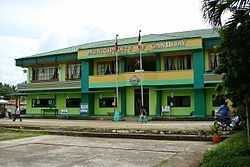Country Philippines Founded 29 November 1854 Time zone PST (UTC+8) Local time Wednesday 12:19 PM | District 3rd district of Bohol Barangay Area 103.3 km² Province Bohol | |
 | ||
Region Central Visayas (Region VII) Weather 25°C, Wind N at 19 km/h, 90% Humidity | ||
Can umantad falls rice terraces candijay bohol
Candijay is a 4th municipal income class municipality in the province of Bohol, Philippines. According to the 2015 census, it has a population of 29,475. In the 2016 electoral roll, it had 19,708 registered voters.
Contents
- Can umantad falls rice terraces candijay bohol
- Map of Candijay Bohol Philippines
- History
- Geography
- Barangays
- Demographics
- Tourism
- References
Map of Candijay, Bohol, Philippines
Candijay is home to the Bohol Island State University (BISU) School of Fisheries, offering college courses related to modern fishing methods and fish preservation. It also has educational facilities for elementary and secondary levels in almost all barangays of the municipality.
History
The name of the town is said to have come from the words "Kang Dihay" meaning belonging to Dihay, a strong man with many followers. The name was eventually changed to Candijay and was organized during the Spanish regime and was then one of the 34 towns in the province in 1879 with a population of 5,030.
The municipality of Candijay was established in 1879 and so was its establishment as a parish. The people were eventually converted to the Roman Catholic religion by the Spaniards. Slowly and through the years, the people adopted themselves to the catholic faith where most of their activities revolved around their church. The parochial church of Candijay is dedicated to Saint Joseph whose feast day is 19 May.
Geography
The municipality of Candijay is located on the eastern side of Bohol, 92 kilometres (57 mi) from Tagbilaran, a two-hour ride away. The town has a land area of 8,687 hectares (21,470 acres).
The town faces Cogtong Bay which has the most diverse mangrove ecosystem in Bohol. The bay is home to 32 of the Philippines' 47 species of mangroves and associates. Yet due to illegal fishing and mismanagement of the mangroves, the mangroves and marine life in the area dwindled. To rectify the damage done, the municipal government is now engaged in a coastal resource management program: the planting of mangroves, though the control and eventual abolition of illegal fishing has yet to be addressed.
Barangays
Candijay comprises 21 barangays.
Demographics
In the 2016 electoral roll, it had 19,708 registered voters, meaning that 67% of the population are aged 18 and over.
Tourism
Candijay has several natural resources. Among these which consequently are visited by both foreign and local tourists are the Can‑umantad Falls which is still being developed, the pristine cold spring Canawa Spring, in Canawa and the Kawasihan Islet Sand Bar in barangay Panas.
There are also some potential eco-tourism destination which consequently start to attract visitors such as the Layog Caves in barangay Luan, Sangat Cave in Tambongan and Ilaja Cave in Panas; the hinterland rice terraces in barangays Tambongan, Canawa, Cadapdapan, Tubod and Abihilan; Danicop Gorge Brook in barangay Cambane; the Kantaligsok Peak which is said to be the tallest peak found in barangay Tugas; as well as the Candijay Mangrove Forests in Panadtaran. The community-based Panadtaran Mangrove Association (PAMAS), which seeks to preserve Panadtaran's mangroves and other natural resources in the area and promote them for eco-tourism pursuits, has now established the Candijay Mangrove Adventure Tour.
Candijay also boasts a man-made lake known as Boongon SWI.
